A complete rotator cuff tear will not heal. Complete ruptures usually require surgery if your goal is to return your shoulder to optimal function. The exception is in elderly patients or patients who have other diseases that increase the risks of surgery. There is some evidence that repairing the rotator cuff within three months of the injury results in a better outcome. You will need to work with your surgeon to determine when is the best time to do the surgery.
Certain types of partial rotator cuff tears may not require surgical repair. If you have a partial tear, your surgeon will most likely want to further evaluate the situation and determine how much the tendon is torn and where the tendon is damaged. This information will be used to decide whether surgery should be recommended or whether you may want to consider non-surgical care for the partial tear of the tendon.
Today, the MRI scan is the most common test used to evaluate the shoulder and determine whether surgery is necessary. Your surgeon will be looking for details of your rotator cuff tear and checking for other problems. As mentioned earlier, a tear usually doesn't occur unless the rotator cuff is already weakened by some other problem. Other potential problems include:
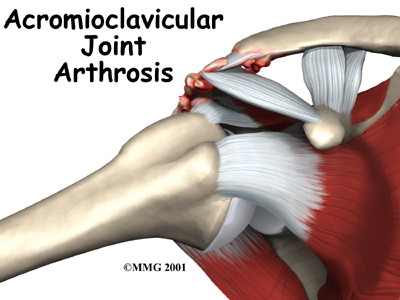
and
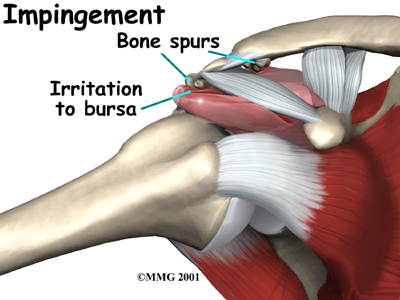 Your surgery may need to address these conditions as well.
Your surgery may need to address these conditions as well.
Related Document: STAR Physical Therapy's Guide to Osteoarthritis of the Acromioclavicular Joint
Related Document: STAR Physical Therapy's Guide to Impingement Syndrome
Arthroscopic Repair
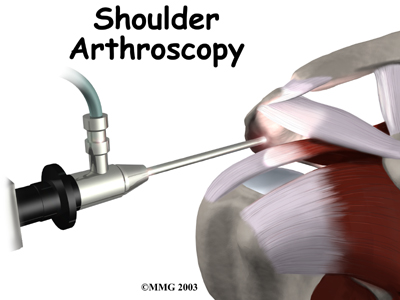 In the past, repair of the rotator cuff tendons usually required an open incision three or four inches in length. As surgeons have become more comfortable using the arthroscope to work in and around the shoulder joint, things have changed. Today, it is much more common to repair tears of the rotator cuff using the .
In the past, repair of the rotator cuff tendons usually required an open incision three or four inches in length. As surgeons have become more comfortable using the arthroscope to work in and around the shoulder joint, things have changed. Today, it is much more common to repair tears of the rotator cuff using the .
An arthroscope is a special type instrument designed to look into a joint, or other space, inside the body. The arthroscope itself is a slender metal tube smaller than a pencil. Inside the metal tube are special strands of glass called fiberoptics. These small strands of glass form a lens that allows one to look into the tube on one end and see what is on the other side - inside the space. This is similar to a microscope or telescope. In the early days of arthroscopy, the surgeon actually looked into one end of the tube. Today, the arthroscope is attached to a small TV camera. The surgeon can watch the TV screen while the arthroscope is moved around in the joint. Using the ability to see inside the joint, the surgeon can then place other instruments into the joint and perform surgery while watching what is happening on the TV screen.
The arthroscope lets the surgeon work in the joint through a very small incision. This may result in less damage to the normal tissues surrounding the joint, leading to faster healing and recovery. If your surgery is done with the arthroscope, you may be able to go home the same day.
To perform the rotator cuff repair using the arthroscope, several small incisions are made to insert the arthroscope and special instruments needed to complete the procedure. These incisions are small, usually about one-quarter inch long. It may be necessary to make three or four incisions around the shoulder to allow the arthroscope to be moved to different locations to see different areas of the shoulder.
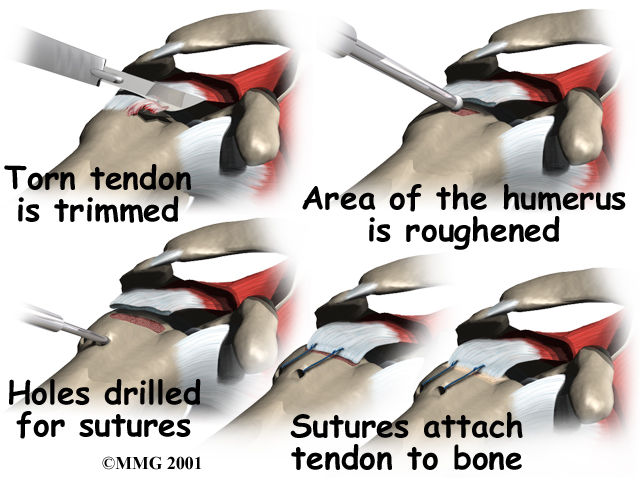 A small plastic, or metal, tube is inserted into the shoulder and connected with sterile plastic tubing to a special pump. Another small tube allows the fluid to be removed from the joint. This pump continuously fills the shoulder joint with sterile saline (salt water) fluid. This constant flow of fluid through the joint inflates the joint and washes any blood and debris from the joint as the surgery is performed.
A small plastic, or metal, tube is inserted into the shoulder and connected with sterile plastic tubing to a special pump. Another small tube allows the fluid to be removed from the joint. This pump continuously fills the shoulder joint with sterile saline (salt water) fluid. This constant flow of fluid through the joint inflates the joint and washes any blood and debris from the joint as the surgery is performed.
There are many small instruments that have been specially designed to perform surgery in the joint. Some of these instruments are used to remove . Some of these instruments nibble away bits of tissue and then vacuum them up from out of the joint. Others are designed to burr away bone tissue and vacuum it out of the joint. These instruments are used to remove any bone spurs that are rubbing on the tendons of the shoulder and smooth the under surface of the acromion and AC joint.
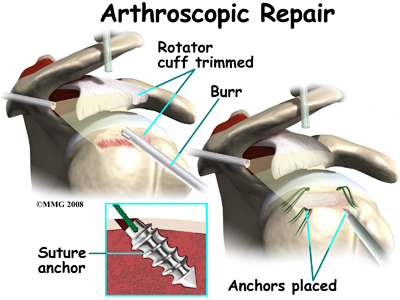
Once any degenerative tissue and bone spurs are removed, the torn rotator cuff tendon can be reattached to the bone. Special devices have been designed to reattach these ligaments. These devices are called suture anchors.
Suture anchors are special devices that have been designed to attach tissue to bone. In the past, many different ways were used to attach soft tissue (such as ligaments and tendons) to bone. The usual methods have included placing stitches through drill holes in the bone, special staples and screws with special washers – all designed to hold the tissue against the bone until healing occurred. Most of these techniques required larger incisions to be able to see what was going on and to get the hardware and soft tissue in the right location.
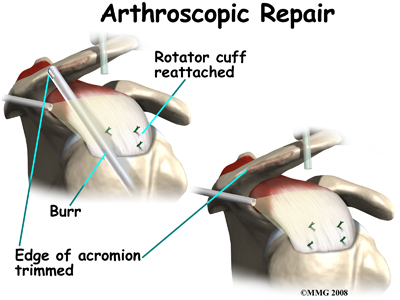
Today, suture anchors have simplified the process and created a much stronger way of attaching soft tissue to bone. These devices are small enough that the can be placed into the appropriate place in the bone through a small incision using the arthroscope. Most of these devices are made of either metal or a special plastic-like material that dissolves over time. This is the “anchor” portion of the device. The anchor is drilled into the bone where the surgeon wished to attach the soft tissue. Sutures are attached to the anchor and threaded through the soft tissue and tied down against the bone.
Open Repair
In some instances, open surgery is necessary. In open surgery, the surgeon gets to the rotator cuff tendon by cutting through muscles and tissues on the front of the shoulder. After repairing the tendon, the muscle on the front is reattached to the bone.
Graft Method
It is not possible to repair all rotator cuff tears. Sometimes the tendon has been torn for too long a period of time. The tendons and muscles become contracted and can't be stretched enough to be reattached. In these cases, the surgeon may use a length of tendon graft to span the distance from the tendon stump of the torn rotator cuff to the humerus.
Salvage Procedure
In other cases, the tendon tissue has simply worn away, and the remaining tendon is not strong enough to hold the necessary stitches. In these instances, simply removing all the torn tissue and fixing any other problems in the shoulder may reduce your pain. But this will probably not increase the strength or motion of your shoulder. It may actually decrease your range of motion.
Portions of this document copyright MMG, LLC.
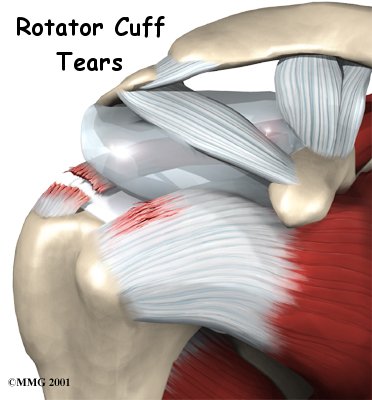
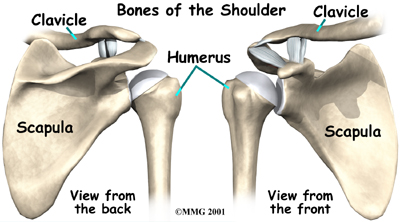
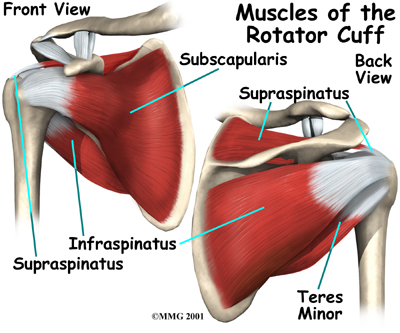
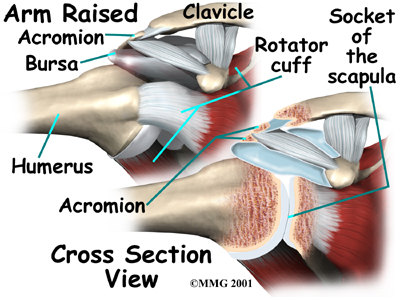
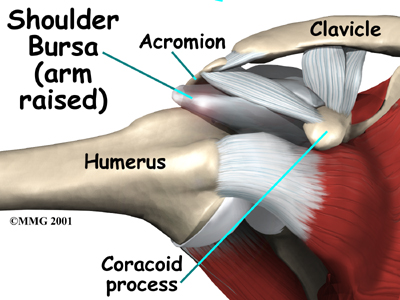
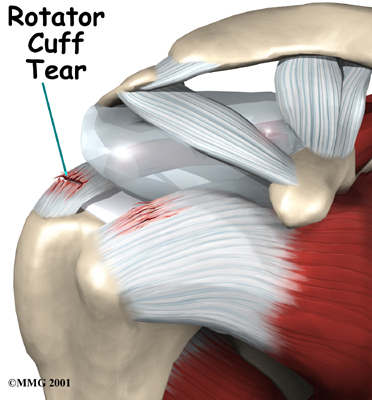
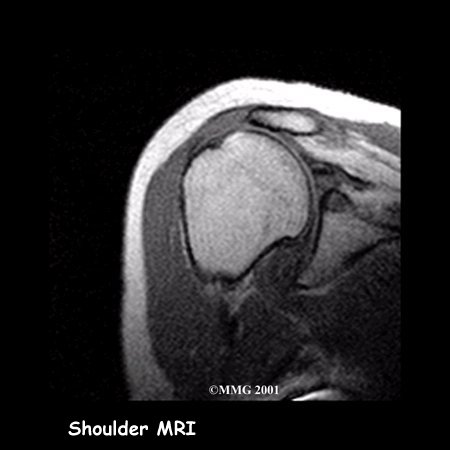
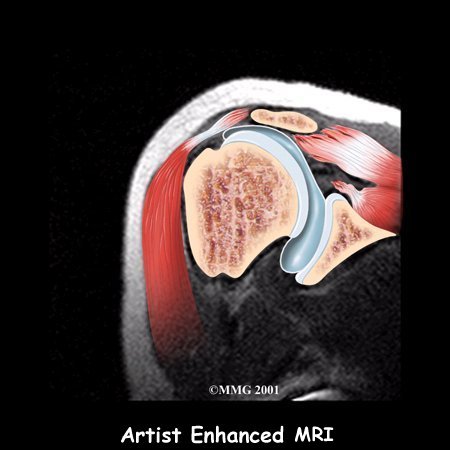

 Your surgery may need to address these conditions as well.
Your surgery may need to address these conditions as well. In the past, repair of the rotator cuff tendons usually required an open incision three or four inches in length. As surgeons have become more comfortable using the arthroscope to work in and around the shoulder joint, things have changed. Today, it is much more common to repair tears of the rotator cuff using the
In the past, repair of the rotator cuff tendons usually required an open incision three or four inches in length. As surgeons have become more comfortable using the arthroscope to work in and around the shoulder joint, things have changed. Today, it is much more common to repair tears of the rotator cuff using the 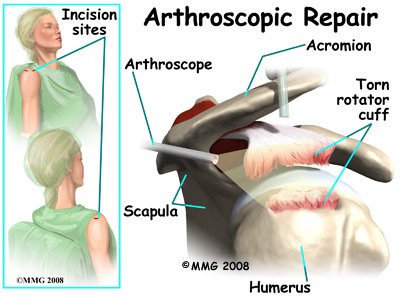
 A small plastic, or metal, tube is inserted into the shoulder and connected with sterile plastic tubing to a special pump. Another small tube allows the fluid to be removed from the joint. This pump continuously fills the shoulder joint with sterile saline (salt water) fluid. This constant flow of fluid through the joint inflates the joint and washes any blood and debris from the joint as the surgery is performed.
A small plastic, or metal, tube is inserted into the shoulder and connected with sterile plastic tubing to a special pump. Another small tube allows the fluid to be removed from the joint. This pump continuously fills the shoulder joint with sterile saline (salt water) fluid. This constant flow of fluid through the joint inflates the joint and washes any blood and debris from the joint as the surgery is performed.
